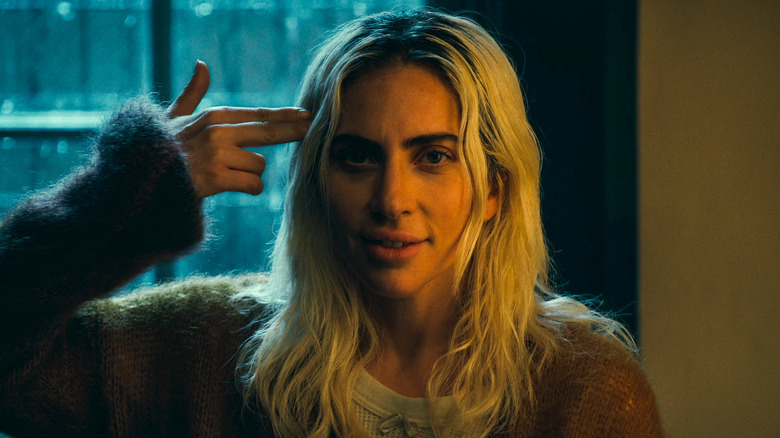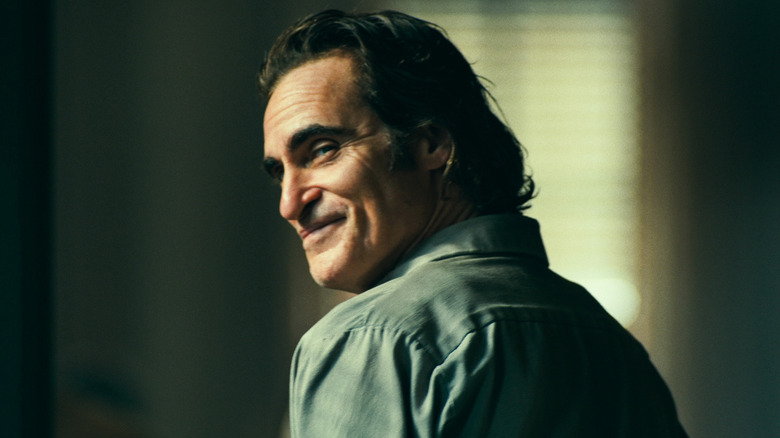Joker: Folie à Deux's Controversial Ending, Explained
Contains spoilers for "Joker: Folie à Deux"
The Joker is back, and that's no laughing matter. Director Todd Phillips' take on Gotham's most notorious clown has returned for a second take in "Joker: Folie à Deux," and this time he's got a lady friend. Joining Joaquin Phoenix's Arthur Fleck for a song, dance, and debate over sanity is Lady Gaga. The pop superstar plays Lee Quinn, a new live-action iteration of Harley Quinn following Margot Robbie's revered three-turn stint, offering a fresh spin on the Joker and Harley's iconic relationship.
Together, this mismatched pair of unhinged individuals bring another dose of chaos to Gotham City following the events of Phillips' 2019 Oscar-winning billion-dollar success, and things end on just as dark and somber a note as the first film. Just like "Joker," though, there will assuredly be plenty of enthusiastic fans who will have their own theories on the sequel's ending and what it all means. Amidst the makeup, madness, and total lack of order during the biggest trial in Gotham's history, just how much of this was all in Arthur's mind? And more importantly, how much of it was put there by his new romantic interest, who takes the well-known character of Harley Quinn and turns it on a very unreliable head?
Arthur Fleck's demise begin with the tears of a clown
It's hard to argue for the trial of your life when you've been living a lie for the latter half of it. That's the conclusion that Arthur eventually reaches and declares to the world, shattering the illusion that his followers have been invested in ever since his fateful appearance on "The Murray Franklin Show" in the first film. Now, Fleck admits to the court that there is no Joker — it was Arthur all along, and he not only committed the murders he's on trial for, but he killed his own mother as well. The confession seals his fate and leads Lee to turn her back on the man she seemingly fell in love with. In the end, just like every other clown in makeup who either stood on the court steps or took a seat at the trial, Arthur wasn't the man they idolized — Joker was.
It's yet another step further away from the Joker comic book character fans know, love, and are terrified of. This is no criminal mastermind who had a plan to get himself off of death row; rather, he's a product of a broken system, someone who doesn't have anything left to keep the illusion going. Just like Joker's iconic nemesis, Batman (who is once again absent from this chapter), the Joker is a symbol formed from one man's traumatic experience and whose delusions seem almost never-ending — including his new romance, which might spark as many fan theories as the last one.
Joker Folie à Deux finally clears up a Joker fan theory by igniting another
When it comes to the women in Arthur Fleck's life, there's been an air of uncertainty about their place in his world. The ending of "Joker" left audience debating whether or not his obsession with Sophie (Zazie Beetz) led to her demise, wondering whether Arthur killed her, or not. "Folie à Deux" finally clarifies this by putting her in the witness stand, verifying that she made it out alive and is now left to recount being one of the earliest victims of Fleck's mental breakdown. Discussing the events of that fateful night, Sophie recounts her conversations with Arthur's mother and the charade her neighbor kept up to try and keep her son happy. It's the tipping point for Arthur to give up his act, but in turn leads to the breakdown in his relationship with Lee which might end earlier than people think.
Just like fans debated if Sophie made it out alive last time round, the same might be worth discussing when it comes to Quinn. After being abandoned by Lee at the courthouse, Arthur calls his formerly devoted darling, pleading to her answer machine with a song down the phone. While he does, Lee raises a gun to her head before we cut back to Arthur who after finally shedding his Joker persona, prepares for his sentencing that ends on an explosive note.
Lee Quinn and Arthur's romance was just one big joke
After a car bomb goes off during Arthur's sentencing, Gotham's clown prince escapes in a similar fashion to how he was escorted by police after the murder of Murray Franklin. Just like in the original film, he flees the vehicle, only this time he's running to the now iconic staircase where Lee is waiting for him. Or is she?
After being reunited with his beloved partner in crime, Arthur begs Quinn to run away with him, only for her to turn him down. She tells Fleck, "It was a fantasy, and you gave it up. You said it yourself, 'I'm not Joker.'" This adds further confirmation that Quinn was never interested in Arthur, but rather the persona that he briefly held on to and that so many got caught up in.
But for a woman obsessed with building a mountain, the reality is that the one she's made for herself was founded on lies. From the truth about her being committed to Arkham Asylum to the legitimacy of her pregnancy, Quinn was never really honest with Arthur. It was only the Joker she had eyes for. What some fans might no doubt be wracking their brains over, however, is if Lee was even waiting there for Arthur at all.
Was Lee's last appearance all in Arthur's head?
For a film that spends so much time dancing around in Arthur's dreams, it's worth wondering how much of each of his realities overlaps with the other. There's no doubt that when the bright light hits, we're very much in Arthur's imagination — but does that include his last meeting with the woman he has mad love for? Just like audiences were left to wonder if Sophie survived her encounter with Arthur in the first film, they now have to question whether Lee hears all of Arthur's message, or did she take her life before he hung up?
When Arthur gives up his act as Joker, Lee is the first to leave the trial, dismayed at her love reverting back to his normal self and giving up the fantasy they were both living. The next time we see her, she puts a gun to her head, and while we don't see her pull the trigger, that doesn't mean she didn't. It's another moment shrouded in ambiguity that ultimately fits the relationship at the center of this film and the consistent uncertainty throughout it. When Arthur has his last face-to-face "encounter" with Lee, she's had a hair change, stopped putting on the makeup, and given up the dream she once had. This could be the last dregs of Arthur's own dream taking shape and parting ways with the reality he's accepted, making way for the brutal consequences yet to be let loose on him.
Could Joker's end lead to the beginning of a new one
Even with all the bright lights flooding "Joker: Folie à Deux," the biggest telegraphed detail was who was going to kill Arthur before the execution chamber could. Named only as Young Inmate on IMDB, Connor Storrie's character had a far more unhinged grin than Arthur throughout the film, so it came as no surprise when he killed him before the credits rolled. Tricking Arthur into hanging back to listen to one last bad joke, the inmate brutally stabs the former Joker repeatedly before he collapses to the floor. As we stay with Arthur in his final moments, just out of focus, his attacker can be heard laughing in the background as he takes his shiv to his own mouth, seemingly giving himself the type of scarred grin Heath Ledger's Joker wore in Christopher Nolan's "The Dark Knight."
What this ending means is, just like the last film's, open to interpretation. Some fans might see this as being similar to Nolan's trilogy, which had John Blake (Joseph Gordon-Levitt) taking up the mantle of a presence that had swept across Gotham — only this one isn't a Caped Crusader dedicated to protecting the city. Fleck's killer, now with a permanent smile, could be the new Joker, one who will send Gotham into even more chaos than Arthur did. Whatever the future holds, though, director Todd Phillips has made it clear that he won't be a part of it.
Joker: Folie à Deux marks a last laugh for director Todd Phillips
When the return of Arthur Fleck was announced, it was met with an obvious question: Did we really need another chapter following this iteration of the Joker? While the first reactions to "Folie à Deux" might suggest that no, we didn't, if there's a chance of exploring this universe a third time, director Todd Phillips won't be a part of it.
Speaking to The Hollywood Reporter, Phillips was asked if he'd return again to this now Fleckless world, possibly shifting the attention to Quinn. "It's not really where this movie is headed for me," he confessed. "I feel like my time in the DC Universe was these two films."
For now, this Joker has certainly had his last laugh, bleak and brutal as it was. Now we have to wait another two years to see if Barry Keoghan returns as his Joker in "The Batman Part II" after his brief appearance sharing giggles with Paul Dano's Riddler in "The Batman." While there's no confirmation on whether he will actually be showing up to cause Robert Pattinson's Dark Knight trouble, it seems like a no-brainer, right? After all, Gotham City's not Gotham without at least one Joker in the deck.






